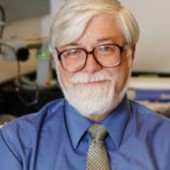In this column, I ask neuroscience professors from around the world the same five questions. Read on to learn more about their research, careers and goals for neuroscience in the future.
Interview with Stephen A. George Ph.D.
Degrees
Ph.D., The Johns Hopkins University, Biophysics (1970)
B.Sc., University of British Columbia, Canada; Physics (1964)
A.M. (honorary), Amherst College (1984)
Awards and Honors
Association of Amherst Students Distinguished Teaching Award (2006)
Grants from the National Science Foundation, National Institutes of Health, the Chaikin-Wile Foundation, and the Alfred P. Sloan Foundation
1. What inspired you to pursue neuroscience as a career?
In high school and as an undergraduate at the University of British Columbia, Canada, I was interested in physics. I worked in a biophysics lab at UBC one summer, and that experience led me to go to graduate school to study how physics can be used to investigate biological questions. At that time (the 1960s) there was no field called “neuroscience,” but as a graduate student in biophysics at Johns Hopkins University in Baltimore, USA, I did research on electrical activity in the nervous system, and that led to my career in neuroscience.
2. What do you think is the most important goal of neuroscience research?
To understand how electrical and biochemical activity in the nervous system underlies behavior and the mind. This basic knowledge is important in itself, and also it will lead to treatments for diseases of the nervous system.
3. What are the main topics and goals of your research?
I am now retired from full-time research and teaching, but when I was doing research I studied how the visual system works, particularly how binocular vision is organized, and also how electrical activity arises and propagates in the nervous system.
4. What accomplishment do you think is the most important out of your own research?
Working with a colleague and with undergraduate students at Amherst College (Massachusetts, USA) I showed that when an ion channel in a nerve membrane opens, the opening of the channel may occur via the process called quantum tunneling, instead of being entirely explained by classical chemical processes. This involvement of quantum mechanics in neural activity has not yet been proven experimentally, but I feel good about having shown it is possible.
5. What do you hope to accomplish in the next 10 years in the field of neuroscience?
Since I am retired I don’t plan to do more research, but I do teach courses occasionally and I am delighted to see many of my former and recent students making great contributions to basic and medical neuroscience research, and also in neuroscience education.
Bonus question: What is your advice to a teenager who wants to learn more about neuroscience?
Students interested in neuroscience naturally would like to be studying the brain and nervous system as much as possible. But, since neuroscience is such a multidisciplinary field, it is really important to learn a lot about science fields that may not seem directly about neuroscience. These are chemistry, math, physics, and biology (especially molecular biology). If as a teenager you can’t take courses specifically in neuroscience, keep your interest up by engaging the many online resources, then go to a college or university that offers neuroscience courses but also provides a solid grounding in those other sciences. And, you are providing a great role model for other high school students by what you are doing in creating this blog!

